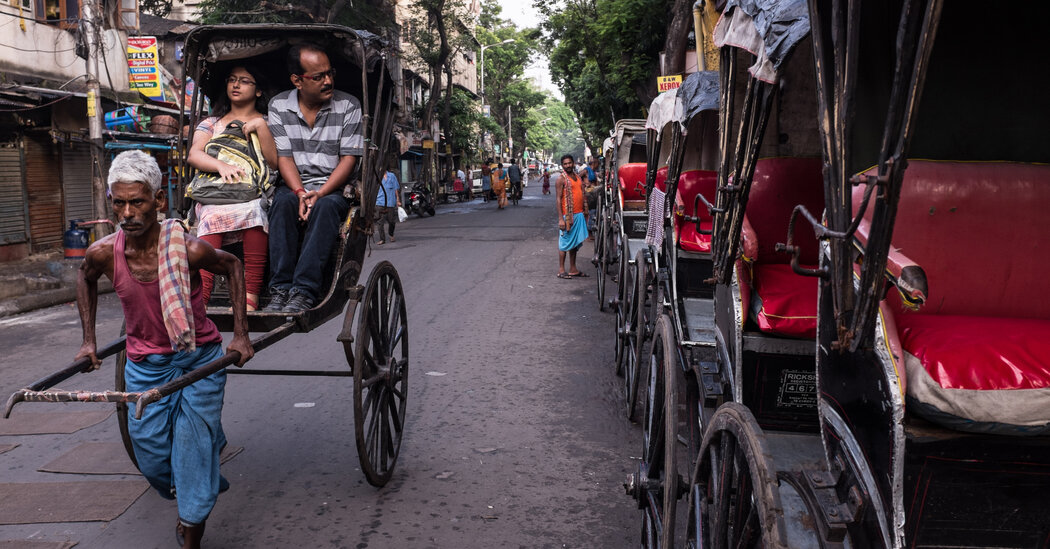ECONOMIC NEWS
Portraits of Kolkata’s Rickshaw Pullers
It was still dark when I met Mohammed near the central market in Kolkata, the capital of the Indian state of West Bengal. He and two other men were piling dozens of enormous jute bags into the carriage of his black-and-red rickshaw — supplies, he said, to be delivered around the city.For Mohammed, it was just the beginning of a long day’s work.Kolkata is among the only places in India — and one of the few left in the world — where fleets of hand-pulled rickshaws still ply the streets.The men who operate them are called rickshaw wallahs. (Wallah is a term for someone who carries or procures something.) Some pull their rickshaws more than 10 miles a day while carrying several hundred pounds — the combined weight of the rickshaw and a couple of occupants. Their daily wages often equate to a few dollars.My job as a photojournalist involves a lot of travel, and I’ve become quite good at acclimatizing to new places. These days, it’s difficult for me to feel culturally disoriented, or dépaysé, as we say in French — literally “out of one’s country.”Yet Kolkata, which I visited in 2018 while on scholarship for a photography workshop, left me with a welcome sense of cultural dislocation. The saris, the sounds of the Bengali language, the smells of the spice markets, the thick monsoon air: All of it contributed to my sense of disorientation in this dense, river delta city of more than 14 million residents. And so, too, did the sight of the rickshaw wallahs, who, often barefoot, pulled their passengers through the crowded streets.Rickshaw wallahs don’t earn a living serving tourists. Their clientele consists mainly of local Kolkatans: shoppers coming to and from markets, or residents transiting the city’s narrow side streets. Schoolchildren, picked up at home and dropped at school every day, often represent a steady income. If someone is sick at night, a rickshaw will do just as well as an ambulance.And when monsoon rains fall, usually between May and September, rickshaws — pulled through waist-deep water — can provide transportation to places that motorized vehicles cannot reach.During the height of India’s Covid crisis, in April and May, many rickshaw wallahs provided an invaluable service, shuttling patients to and from clinics and hospitals. Others were forced to leave Kolkata and return to their home villages during the lockdown. (In many places in India and elsewhere, the pandemic has led to a mass exodus of migrant laborers.)Over the years, human rights groups and governing authorities have tried to curb the use of hand-pulled rickshaws, which some see as a degrading colonial anachronism. Local authorities officially banned the vehicles in 2006 and have stopped issuing or renewing licenses, while promising that the government would offer training for alternative livelihoods.But for the hundreds, if not thousands, of pullers who remain (some estimates place the number of remaining rickshaw wallahs at between 500, some at 5,000), rickshaws are often their only reliable source of income.Not all of the men I met were willing to have their pictures taken. Some wondered what good it would do. But others, like Mohammed, were eager to share their stories.One young man described his frustration with the police, who, on occasion, issue fines, confiscate rickshaws or demand bribes. “They know where we are and where we work,” he told me. “They just do it for the money — and then we have to earn it back.”Many rickshaw pullers are migrants from the neighboring state of Bihar. With the exception of the meager funds they keep for their daily needs, they send much of what they earn home to their families.Bihar has one of the lowest literacy rates in all India. In fact, none of the men I met knew how to read or write.But Mohammed took pride in telling me that his children in Bihar are attending school.“All of them,” he added with a candid smile, “thanks to the money I’m sending.”After we talked, I watched as he bent down to pick up his set of handles and walked away. Before long, all I could see was the black patch of his rickshaw vanishing around a corner.Emilienne Malfatto is a photojournalist and writer based in Iraq and Southern Europe. You can follow her work on Instagram and Twitter.
Source link













